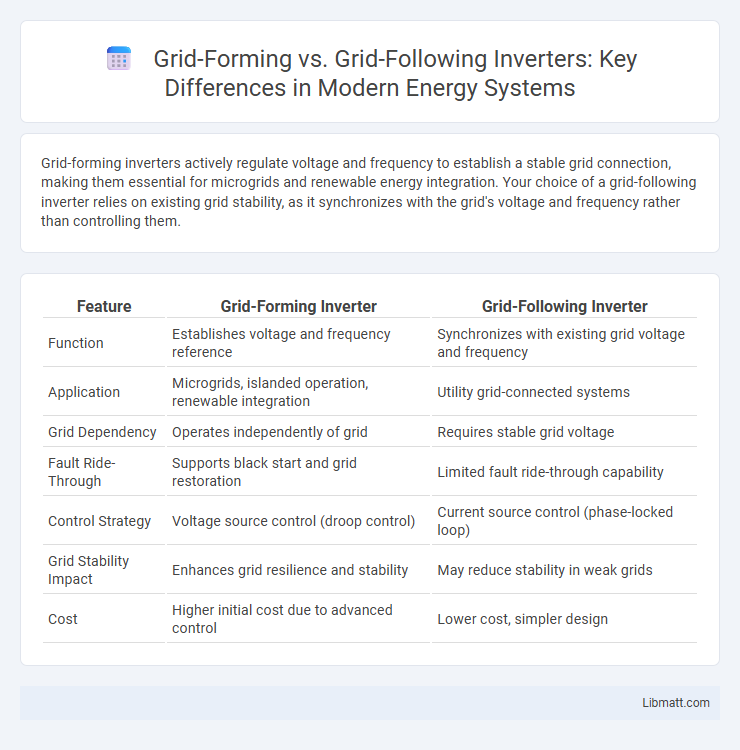Grid-forming inverters actively regulate voltage and frequency to establish a stable grid connection, making them essential for microgrids and renewable energy integration. Your choice of a grid-following inverter relies on existing grid stability, as it synchronizes with the grid's voltage and frequency rather than controlling them.
Table of Comparison
| Feature | Grid-Forming Inverter | Grid-Following Inverter |
|---|---|---|
| Function | Establishes voltage and frequency reference | Synchronizes with existing grid voltage and frequency |
| Application | Microgrids, islanded operation, renewable integration | Utility grid-connected systems |
| Grid Dependency | Operates independently of grid | Requires stable grid voltage |
| Fault Ride-Through | Supports black start and grid restoration | Limited fault ride-through capability |
| Control Strategy | Voltage source control (droop control) | Current source control (phase-locked loop) |
| Grid Stability Impact | Enhances grid resilience and stability | May reduce stability in weak grids |
| Cost | Higher initial cost due to advanced control | Lower cost, simpler design |
Introduction to Grid-Forming and Grid-Following Inverters
Grid-forming inverters generate their own voltage and frequency reference, enabling stable operation in islanded or weak grid conditions by actively controlling the grid waveform. Grid-following inverters synchronize with an existing grid voltage and frequency, injecting power by tracking and aligning with the grid's parameters. The fundamental difference lies in grid-forming inverters' ability to establish grid conditions, whereas grid-following inverters depend on the grid for their operational reference.
Key Differences Between Grid-Forming and Grid-Following Inverters
Grid-forming inverters create and regulate their own voltage and frequency, allowing them to operate independently and provide stable power in islanded or weak grid conditions. In contrast, grid-following inverters rely on the existing grid voltage and frequency, synchronizing their output accordingly, making them suitable for strong grid connections. Understanding these key differences helps optimize your renewable energy system's performance and reliability.
Grid-Forming Inverters: Definition and Working Principle
Grid-forming inverters are power electronic devices that generate a stable voltage and frequency reference, enabling them to operate independently of the main grid by creating a self-sustaining AC waveform. These inverters regulate grid parameters by controlling output voltage and frequency, allowing them to form microgrids or support islanded systems with high renewable energy penetration. Your energy system benefits from enhanced stability and resilience due to their ability to seamlessly manage power flow without relying on an external grid signal.
Grid-Following Inverters: Definition and Operation Mechanism
Grid-following inverters synchronize their output to the existing grid voltage and frequency, relying on the grid as a reference while injecting current accordingly. These inverters use phase-locked loops (PLLs) to track grid signals, ensuring stable operation but cannot operate independently during grid outages. Your choice of a grid-following inverter is optimal for systems connected to a strong, stable grid where seamless integration and power quality are essential.
Control Strategies of Grid-Forming vs Grid-Following Inverters
Grid-forming inverters use voltage and frequency control to establish stable voltage waveforms independently, enabling them to operate autonomously in microgrids or islanded systems. Grid-following inverters rely on phase-locked loops (PLLs) to synchronize with the existing grid voltage and frequency, adjusting their output current accordingly. The control strategy difference allows grid-forming inverters to provide grid support and black start capabilities, whereas grid-following inverters primarily inject power while depending on the external grid reference.
Applications and Use Cases in Modern Power Systems
Grid-forming inverters are essential in microgrids and renewable energy systems where they provide voltage and frequency reference, enabling stable islanded operation and black start capabilities. Grid-following inverters excel in grid-tied applications like solar PV and wind farms, synchronizing with the existing grid's voltage and frequency to inject power efficiently. Your choice depends on whether autonomous grid stability or seamless integration with a strong grid is the priority in modern power systems.
Advantages of Grid-Forming Inverters
Grid-forming inverters provide enhanced stability and reliability by actively regulating voltage and frequency, enabling autonomous operation in islanded or weak grid conditions. They improve resilience in microgrids and renewable energy systems by supporting black start capabilities and seamless grid reconnection. Compared to grid-following inverters, grid-forming inverters contribute to better grid support, fault ride-through performance, and overall power quality.
Limitations of Grid-Following Inverters
Grid-following inverters rely on an existing grid voltage and frequency reference, making them unsuitable for standalone or weak grid conditions due to their inability to establish grid stability independently. They exhibit limited fault ride-through capabilities, causing potential disconnection during voltage sags or disturbances, which can jeopardize system reliability. Furthermore, grid-following inverters lack autonomous voltage regulation and frequency support, restricting their effectiveness in microgrids and renewable integration where grid resilience is critical.
Transitioning to Future Grid Architectures
Grid-forming inverters enable autonomous voltage and frequency regulation, crucial for integrating decentralized renewable energy sources into future grid architectures characterized by high inverter penetration. These inverters support islanding and black start capabilities, enhancing grid resilience and stability during disturbances. In contrast, grid-following inverters rely on existing grid signals for synchronization, limiting their effectiveness in low-inertia or weak grid scenarios typical of emerging renewable-rich power systems.
Conclusion: Choosing the Right Inverter for Grid Stability
Grid-forming inverters establish stable voltage and frequency reference points, making them essential for maintaining grid stability during fluctuations or islanded operation, while grid-following inverters rely on the existing grid voltage and frequency signals, making them suitable for stable, grid-tied environments. Your choice should depend on the specific application, grid conditions, and the need for autonomous operation or grid support services. Prioritizing grid stability requires selecting grid-forming inverters in scenarios requiring resilience and active grid support, whereas grid-following inverters are ideal for well-established, stable grids.
Grid-forming inverter vs Grid-following inverter Infographic

 libmatt.com
libmatt.com